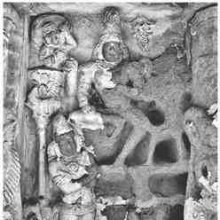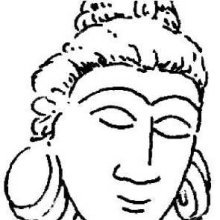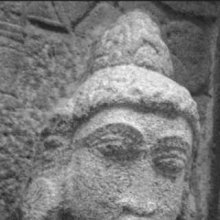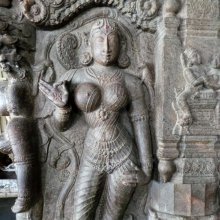Rati, Ratī, Rāti, Rāṭi: 53 definitions
Introduction:
Rati means something in Buddhism, Pali, Hinduism, Sanskrit, Jainism, Prakrit, the history of ancient India, Marathi, Hindi, biology, Tamil. If you want to know the exact meaning, history, etymology or English translation of this term then check out the descriptions on this page. Add your comment or reference to a book if you want to contribute to this summary article.
Images (photo gallery)
(+1 more images available)
In Hinduism
Shaktism (Shakta philosophy)
Source: Wisdom Library: ŚāktismRati (रति, “pleasure, enjoyment”):—Name of one of the sixty-four mātṛs to be worshipped during Āvaraṇapūjā (“Worship of the Circuit of Goddesses”, or “Durgā’s Retinue”), according to the Durgāpūjātattva. They should be worshipped with either the five upācāras or perfume and flowers.
Her mantra is as follows:
Source: Google Books: Manthanabhairavatantramॐ रत्यै नमः
oṃ ratyai namaḥ.
Rati (रति) refers to one of the eight Kaula consorts (dūtī-aṣṭaka) associated with Nādapīṭha (identified with Kulūta), according to the Manthānabhairavatantra, a vast sprawling work that belongs to a corpus of Tantric texts concerned with the worship of the goddess Kubjikā.—[...] The eight Kaula consorts (dūtyaṣṭaka): Nivṛti, Pratiṣṭhā, Vidyā, Śānti, Kāladūtī, Mahārāvā, Rati, Prītikarī.

Shakta (शाक्त, śākta) or Shaktism (śāktism) represents a tradition of Hinduism where the Goddess (Devi) is revered and worshipped. Shakta literature includes a range of scriptures, including various Agamas and Tantras, although its roots may be traced back to the Vedas.
Pancaratra (worship of Nārāyaṇa)
Source: Wisdom Library: PāñcarātraRati (रति, “sexual-pleasure”):—One of the twenty-four emanations of Lakṣmī accompanying Nārāyaṇa. This particular manifestation couples with his counterpart form called Aniruddha and together they form the sixteenth celestial couple. Lakṣmī represents a form of the Goddess (Devī) as the wife of Viṣṇu, while Nārāyaṇa represents the personification of his creative energy, according to the Pāñcarātra literature.
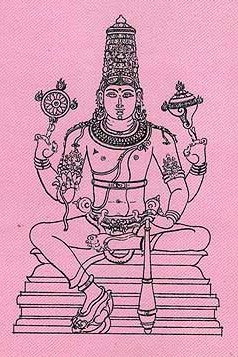
Pancaratra (पाञ्चरात्र, pāñcarātra) represents a tradition of Hinduism where Narayana is revered and worshipped. Closeley related to Vaishnavism, the Pancaratra literature includes various Agamas and tantras incorporating many Vaishnava philosophies.
Shilpashastra (iconography)
Source: Red Zambala: Hindu Icons and Symbols | DeviRati (रति, “power of lust”).—The agency of Śiva’s procreation is the Goddess known as Rati — the wife of Kāma-deva. Without sexual desire no conception takes place. She appears to be the very opposite of the power of destruction — Kālī (“the power of time”).
The Goddess Rati is the libido — the ubiquitous force of lust, of enjoyment, but strangely enough also the power of liberation — for liberation from the bonds of material nature is not a passive or a neutral state but indeed an very pro-active struggle.
Source: Archaeological Survey of India: Śaiva monuments at Paṭṭadakal (śilpa)Rati (रति) is found as a sculpture on the eastern wall of the outer maṇḍapa of the temple of Pāpanātha.—In the south portion after the eastern entrance a pilaster bears the image of Kāma and Rati. The male figure of a standing couple holds a bouquet of flowers in his right hand and a sugarcane in the left. The presence of flowers and sugarcane in his hands makes us to think of Kāma and his consort Rati, but there is no guarantee for our interpretation.
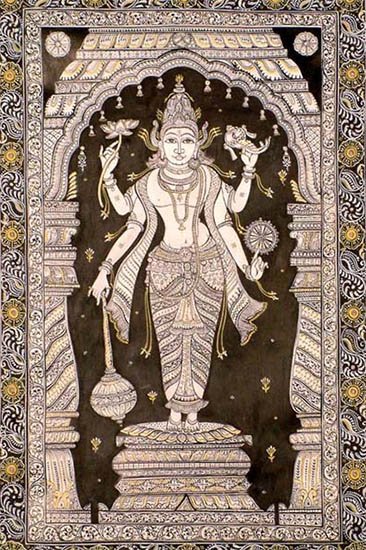
Shilpashastra (शिल्पशास्त्र, śilpaśāstra) represents the ancient Indian science (shastra) of creative arts (shilpa) such as sculpture, iconography and painting. Closely related to Vastushastra (architecture), they often share the same literature.
Natyashastra (theatrics and dramaturgy)
Source: Wisdom Library: Nāṭya-śāstra1) Rati (रति, “love”).—One of the eight ‘permanent states’ (sthāyibhāva), according to the Nāṭyaśāstra chapter 7.31. These ‘permanent states’ are called ‘the source of delight’ and are not interfered with by other States. The term is used throughout nāṭyaśāstra literature. (Also see the Daśarūpa 4.43-44)
Rati, which has pleasure as its basis, is caused by determinants (vibhāva) like seasons, garlands, unguent, ornaments, dear ones, enjoyment of a superior residential house, and absence of opposition [from any one]. It is to be represented on the stage by consequents (anubhāva) such as a smiling face, sweet words, motion of eyebrows, and glances and the like.
2) Rati (रति) is the name of a meter belonging to the Drutā class of Dhruvā (songs) described in the Nāṭyaśāstra chapter 32:—“The metre which has in its feet, the sixth, the tenth, the thirteenth, the sixteenth and the last long, is rati”.
Source: Shodhganga: Mankhaka a sanskrit literary genius (natya)Rati (रति) refers to permanent mood of Śṛṅgāra-rasa. Dhanañjaya holds that when a pair of young man and woman feels mutual longing due to favourable place, time, dress, sports etc., that feeling is called rati or love and this rati, being fully experienced through various graceful actions, attains the status of the sentiment called Śṛṅgāra.
Source: Shodhganga: Elements of Art and Architecture in the Trtiyakhanda of the Visnudharmottarapurana (natya)Rati (रति) or “erotic emotion” is the sthāyībhāva (“durable psychological state”) associated with Śṛṅgāra or the “erotic sentiment”, which represents one of the nine kinds of Rasa (“soul of Drama”), according to the Viṣṇudharmottarapurāṇa, an ancient Sanskrit text which (being encyclopedic in nature) deals with a variety of cultural topics such as arts, architecture, music, grammar and astronomy.—Śṛṇgāra-rasa is the sentiment of love and desire where the manifestation of the activities of Kāmadeva i.e the god of love can be noticed. Rati i.e erotic emotion is the sthāyībhāva or permanent feeling of śṛṇgāra. Śyāma i.e dark blue is the colour of this sentiment. Viṣṇu is the God of this sentiment.

Natyashastra (नाट्यशास्त्र, nāṭyaśāstra) refers to both the ancient Indian tradition (shastra) of performing arts, (natya—theatrics, drama, dance, music), as well as the name of a Sanskrit work dealing with these subjects. It also teaches the rules for composing Dramatic plays (nataka), construction and performance of Theater, and Poetic works (kavya).
Purana and Itihasa (epic history)
Source: archive.org: Puranic Encyclopedia1) Rati (रति).—Wife of Kāmadeva and some Purāṇas hold the view that Kāma was the son of Dharma whose father was Brahmā. But, the story of Kāma and Rati is described in the Kālikāpurāṇa as follows.
Brahmā created ten prajāpatis. A beautiful lady called Sandhyā was his next creation. As soon as she was born, seeing her exquisite beauty Brahmā and the prajāpatis jumped to their feet. All of them thought in the same way. While the court of Brahmā was in such a perplexed confusion, an extremly handsome person emerged from his mind. Fish was the symbol on his flag, and he aked Brahmā thus: "Oh father, what should I do? Give me a suitable name and you should also decide upon a place and position and also a wife for me." Brahmā told him as follows:—"You be moving about everywhere in this world (full of men andwomen) engaged in the eternal function of creation with the five arrows of flower in your hands and thus multiply the population. Your arrows will go everywhere and no one, not even the Devas will dare to obstruct your arrows. Everyone will yield to your behests. Viṣṇu, Śiva and I also will yield before your arrows. You will enter the hearts of living beings in invisible form and giving them happiness engage yourself in eternal creation. The chief aim and object of your arrows of flower will be the hearts of living beings. You will be given a suitable name just now." (See full article at Story of Rati from the Puranic encyclopaedia by Vettam Mani)
2) Rati (रति).—An apsarā woman of Alakāpurī. She danced on the occasion of Kubera welcoming Aṣṭāvakramuni. (Anuśāsana Parva, Chapter 19, Verse 45).
3) Rati (रति).—Wife of Vibhu born in the dynasty of King Ṛṣabhadeva of Ajanābhavarṣa. Pṛthuṣeṇā was her daughter. (Bhāgavata, 5th Skandha).
Source: archive.org: Shiva Purana - English Translation1) Rati (रति) is the name of a Goddess that came into existence from Dakṣa’s sweat, according to the Śivapurāṇa 2.2.3. Accordingly, as Dakṣa perspired:—“[...] From the drops of sweat that fell from Dakṣa’s body, a splendid woman endowed with good qualities was born. She was of slender body with symmetrical hips. Her waist was well-shaped; small curly hairs embellished it. She was soft in body with fine teeth. She had a shining golden complexion. In her body, she was perfect. Her face shone like the full moon and full-blown lotus. Her name was Rati. She was capable of captivating even the sages”.
2) Rati (रति) refers to “sexual dalliance”, according to the Śivapurāṇa 2.3.35 (“The story of Padmā and Pippalāda”).—Accordingly, as Dharma (in the guise of a king) said to Padmā (wife of sage Pippalāda): “O beautiful woman, you are Lakṣmī herself; you are charming, you are worthy of a king; you are in the very prime of youth; you will be ever young; you are a lovely sweet lady. I am telling you the truth, O slender-limbed lady. You lack lustre and colour in the presence of the sage Pippalāda who is old and weak. Cast off that ruthless old Brahmin always engaged in penances. Look up to me a great king, heroic in sexual dalliance (rati-śūra) and agitated by Kāma. [...]”.
3) Rati (रति) refers to one of the sixteen celestial ladies (Divyanārī), according to the Śivapurāṇa 2.3.50 (“Description of fun and frolic”).—Accordingly, as Brahmā narrated to Nārada: “[...] Then the sixteen celestial ladies arrived there and saw the couple [i.e., Śiva and Pārvatī] with great respect. They were Sarasvatī, Lakṣmī, Sāvitrī, Jāhnavī, Aditi, Śacī, Lopāmudrā, Arundhatī, Ahalyā, Tulasī, Svāhā, Rohiṇī, Vasundharā, Śatarūpā, Saṃjñā and Rati. There were several virgins of the gods, Nāgas, and the sages. They were charming and attractive. Who can enumerate them? [...]”.
Source: Cologne Digital Sanskrit Dictionaries: The Purana Index1a) Rati (रति).—A name of Śatarūpā; wife of Svāyambhuva Manu.*
- * Brahmāṇḍa-purāṇa II. 9. 38; Vāyu-purāṇa 10. 13.
1b) The consort of Kāma. Hearing that he was burnt by Śiva, she clad herself in sorrowful clothes. Śyāmalā restored him back to life, and in her presence both were married again;1 a śakti;2 mother of Harṣa;3 Prīti became her co-wife; after the burning of Kāma, was Māyāvatī in Śambara's house and brought up Pradyumna (an incarnation of Kāma);4 Image of, with swan.5
- 1) Brahmāṇḍa-purāṇa IV. 30. 37-51; Matsya-purāṇa 7. 13; 100. 32; 154. 219, 272-3;
- 2) Brahmāṇḍa-purāṇa IV. 19. 64-71; 44; 72.
- 3) Vāyu-purāṇa 10. 38.
- 4) Viṣṇu-purāṇa I. 7. 31; V. 27. 30.
- 5) Matsya-purāṇa 261. 55.
1c) A kalā of the moon.*
- * Brahmāṇḍa-purāṇa IV. 35. 92.
1d) A son of Śatarūpā.*
- * Matsya-purāṇa 4. 25.
2a) Ratī (रती).—The wife of Vibhu and mother of Pṛthusena.*
- * Bhāgavata-purāṇa V. 15. 6.
2b) See Māyāvatī.*
- * Bhāgavata-purāṇa X. 55. 7.
Rati (रति) refers to the name of a Lady mentioned in the Mahābhārata (cf. I.60.32). Note: The Mahābhārata (mentioning Rati) is a Sanskrit epic poem consisting of 100,000 ślokas (metrical verses) and is over 2000 years old.

The Purana (पुराण, purāṇas) refers to Sanskrit literature preserving ancient India’s vast cultural history, including historical legends, religious ceremonies, various arts and sciences. The eighteen mahapuranas total over 400,000 shlokas (metrical couplets) and date to at least several centuries BCE.
Kavya (poetry)
Source: Wisdom Library: KathāsaritsāgaraRati (रति) is the wife of Kāma (god of love), who was destined to be reunited with Kāma’s human incarnation Naravāhanadatta, according to the Kathāsaritsāgara, chapter 34. Accordingly, as Śiva said to Rati: “that husband of thine [Kāma], who was formerly consumed, has been born in the palace of the King of Vatsa, under the name of Naravāhanadatta, conceived in a mortal womb on account of disrespect shown to me. But because thou hast propitiated me thou shalt also be born in the world of mortals, without being conceived in a mortal womb; and then thou shalt be reunited to thy husband, once more possessing a body”.
The Kathāsaritsāgara (‘ocean of streams of story’), mentioning Rati, is a famous Sanskrit epic story revolving around prince Naravāhanadatta and his quest to become the emperor of the vidyādharas (celestial beings). The work is said to have been an adaptation of Guṇāḍhya’s Bṛhatkathā consisting of 100,000 verses, which in turn is part of a larger work containing 700,000 verses.
Source: Shodhganga: A critical appreciation of soddhalas udayasundarikathaRati (रति).—Rati is a consort of Madana (god of love). The character of Rati is vividly drawn in the famous Rativilāpa of the Kumārasambhava.

Kavya (काव्य, kavya) refers to Sanskrit poetry, a popular ancient Indian tradition of literature. There have been many Sanskrit poets over the ages, hailing from ancient India and beyond. This topic includes mahakavya, or ‘epic poetry’ and natya, or ‘dramatic poetry’.
Ayurveda (science of life)
Rasashastra (Alchemy and Herbo-Mineral preparations)
Source: archive.org: Rasa-Jala-Nidhi: Or Ocean of indian chemistry and alchemyRati is the same as Rakti. (see Bhudeb Mookerji and his Rasajalanidhi)
Unclassified Ayurveda definitions
Source: gurumukhi.ru: Ayurveda glossary of termsRati (रति):—[ratiḥ] Delight; Desire; Love; Name of the wife of Kamadeva god of Love

Āyurveda (आयुर्वेद, ayurveda) is a branch of Indian science dealing with medicine, herbalism, taxology, anatomy, surgery, alchemy and related topics. Traditional practice of Āyurveda in ancient India dates back to at least the first millenium BC. Literature is commonly written in Sanskrit using various poetic metres.
Kavyashastra (science of poetry)
Source: Shodhganga: The Kavyavilasa of Ciranjiva Bhattacarya (kavyashastra)Rati (रति, “love”) as defined by Cirañjīva Bhaṭṭācārya (fl. 17th century).—Cirañjīva defines bhāva as follows:—“when rati is related to the gods etc. it is called bhāva”. According to Sanskrit rhetoricians rati (love) is not always sufficiently developed into śṛṅgāra-rasa. When rati (passion) is related to man and woman it develops into śṛṅgāra-rasa. But when this rati exists in the form of devotion to gods or when this rati is in between the son and the mother or two brothers it can not be developed into śṛṅgāra. Then it is simply known as bhāva (emotion) as distinguished from the so called rati.
Source: Shodhganga: Bhismacaritam a critical studyRati (रति) refers to one of the different Bhāvas employed in the Bhīṣmacarita (Bhishma Charitra) which is a mahākāvya (‘epic poem’) written by Hari Narayan Dikshit.— The example of rati-bhāva is IX.57.—Here we can see the sense of peace arose in the mind of Bhīṣma after listening to the valuable advice advocated by Lord Kṛṣṇa. Before this he was very much tensed and worried. After listening to the valuable suggestions advocated by Lord Kṛṣṇa his mind becomes calm and serene. Thus the sense of peace and calm is depicted in the present example.

Kavyashastra (काव्यशास्त्र, kāvyaśāstra) refers to the ancient Indian tradition of poetry (kavya). Canonical literature (shastra) of the includes encyclopedic manuals dealing with prosody, rhetoric and various other guidelines serving to teach the poet how to compose literature.
Vaishnavism (Vaishava dharma)
Source: Pure Bhakti: Bhagavad-gita (4th edition)Rati (रति) refers to “(1) Attachment, fondness (2) A stage in the development of bhakti which is synonymous with bhāva”. (cf. Glossary page from Śrīmad-Bhagavad-Gītā).
Source: Pure Bhakti: Bhajana-rahasya - 2nd EditionRati (रति) refers to:—(1) attachment, fondness for; (2) a stage in the development of bhakti which is synonymous with bhāva (see Bhāva). (cf. Glossary page from Bhajana-Rahasya).
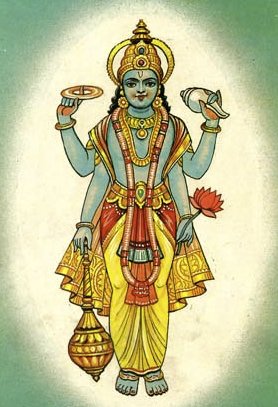
Vaishnava (वैष्णव, vaiṣṇava) or vaishnavism (vaiṣṇavism) represents a tradition of Hinduism worshipping Vishnu as the supreme Lord. Similar to the Shaktism and Shaivism traditions, Vaishnavism also developed as an individual movement, famous for its exposition of the dashavatara (‘ten avatars of Vishnu’).
Shaivism (Shaiva philosophy)
Source: Brill: Śaivism and the Tantric TraditionsRati (रति) refers to “delight (in indifference)”, according to the Vārāṇasīmāhātmya verse 1.116-125.—Accordingly, “[...] And there is no rebirth (udbhava) in this world for those Pāśupata sages who follow the observance of the skull, they who abide by the Atimārga. For the practitioners of the Atimārga there is only indifference. Those who have set out on the Atimārga only delight in indifference (rati). Those who die on the saline ground go along that path, but of all saline grounds Vārāṇasī is the best, O sage. And there is no sprouting for those who die there. The body abandoned on the cremation ground merges in the Lord of Time. [...]”.

Shaiva (शैव, śaiva) or Shaivism (śaivism) represents a tradition of Hinduism worshiping Shiva as the supreme being. Closely related to Shaktism, Shaiva literature includes a range of scriptures, including Tantras, while the root of this tradition may be traced back to the ancient Vedas.
General definition (in Hinduism)
Source: Apam Napat: Indian MythologyRati is the daughter of the Daksha and the wife of the God of love, Kama. She is said to be the embodiment of beauty and also held to be incomparable in her charm and grace. When her husband was burned to death by the anger of Shiva, she successfully pleaded for his life.
Source: WikiPedia: HinduismRati (रति, Rati) is the Hindu goddess of love, carnal desire, lust, passion and sexual pleasure. Usually described as the daughter of Prajapati Daksha, Rati is the female counterpart, the chief consort and the assistant of Kama (Kamadeva), the god of love. A constant companion of Kama, she is often depicted with him in legend and temple sculpture. She also enjoys worship along with Kama. Rati is often associated with the arousal and delight of sexual activity, and many sex techniques and positions derive their Sanskrit names from hers.
The name of the goddess Rati comes from the Sanskrit root ram, meaning "enjoy" or "delight in." Although the verb root generally refers to any sort of enjoyment, it usually carries connotations of physical and sensual enjoyment. Etymologically, the word rati refers to anything that can be enjoyed; but, it is almost always used to refer to sexual love.
In Buddhism
Theravada (major branch of Buddhism)
Source: Pali Kanon: Pali Proper NamesOne of the daughters of Mara (q.v.).
Theravāda is a major branch of Buddhism having the the Pali canon (tipitaka) as their canonical literature, which includes the vinaya-pitaka (monastic rules), the sutta-pitaka (Buddhist sermons) and the abhidhamma-pitaka (philosophy and psychology).
Tibetan Buddhism (Vajrayana or tantric Buddhism)
Source: Google Books: An Illustrated History of the MandalaRati (रति, “delight”) refers to one of the Seventeen Viśuddhipadas (“stations of purity”) and is associated with the deity Hāsyā, according to the Prajñāpāramitānayasūtra: an ancient Buddhist Tantric text recited daily in the Japanese Shingon sect which is closely related to the Sarvatathāgatatattvasaṃgraha.—The visualization of the seventeen-deity maṇḍala, representing the deification of the seventeen Viśuddhipadas [e.g., rati], was thought to facilitate the attainment of enlightenment through the sublimation of the defilements into the mind of enlightenment (bodhicitta).
Source: academia.edu: The Structure and Meanings of the Heruka MaṇḍalaRatī (रती) is the name of a Ḍākinī who, together with the Vīra (hero) named Rati forms one of the 36 pairs situated in the Jñānacakra, according to the 10th century Ḍākārṇava chapter 15. Accordingly, the jñānacakra refers to one of the three divisions of the saṃbhoga-puṭa (‘enjoyment layer’), situated in the Herukamaṇḍala. The 36 pairs of Ḍākinīs [viz., Ratī] and Vīras are white in color; the shapes of their faces are in accordance with their names; they have four arms; they hold a skull bowl, a skull staff, a small drum, and a knife.
Note: In Ratnasena’s Maṇḍalārcanavidhi, Ratī is Ratiratā (or Ravinabhā) (Skt ms. NGMPP B 24/52, 16 v 2)
Source: OSU Press: Cakrasamvara SamadhiRati (रति) refers to “pleasure”, according to the Cakrasaṃvara Samādhi [i.e., Cakrasamvara Meditation] ritual often performed in combination with the Cakrasaṃvara Samādhi, which refers to the primary pūjā and sādhanā practice of Newah Mahāyāna-Vajrayāna Buddhists in Nepal.—Accordingly, “The letter E shape, abode of strong essence, the womb space of the lotus, Therein the midst, a secret Vaṃ, a beautiful bowl, the origin of all one’s self, An abode of perfectly pure awakened omniscience, beautiful divine power, And I, innately pure, praise the highest pleasure (vara-rati), the innate heroic couple”.

Tibetan Buddhism includes schools such as Nyingma, Kadampa, Kagyu and Gelug. Their primary canon of literature is divided in two broad categories: The Kangyur, which consists of Buddha’s words, and the Tengyur, which includes commentaries from various sources. Esotericism and tantra techniques (vajrayāna) are collected indepently.
Mahayana (major branch of Buddhism)
Source: academia.edu: A Study and Translation of the GaganagañjaparipṛcchāRati (रति) refers to “delight (in the dharma)”, according to the Gaganagañjaparipṛcchā: the eighth chapter of the Mahāsaṃnipāta (a collection of Mahāyāna Buddhist Sūtras).—Accordingly, as Gaganagañja said to Ratnapāṇi: “Son of good family, those sixty-four dharmas are included in one hundred twenty-eight dharmas. What are those one hundred twenty-four? [...] (29) no agitation is included in going and reaching to the utmost limit; (30) no objection is included in truth and delight in the dharma (dharma-rati); (31) renounce is included in knowing the cause and getting rid of false views; (32) eliminating the concept of mine is included in the absence of what belongs to the ego and property; [...]’”.

Mahayana (महायान, mahāyāna) is a major branch of Buddhism focusing on the path of a Bodhisattva (spiritual aspirants/ enlightened beings). Extant literature is vast and primarely composed in the Sanskrit language. There are many sūtras of which some of the earliest are the various Prajñāpāramitā sūtras.
In Jainism
General definition (in Jainism)
Source: archive.org: Jaina YogaRati (रति, “pleasure”) refers to a subclass of the interal (abhyantara) division of parigraha (attachment) and is related to the Aparigraha-vrata (vow of non-attachment). Amṛtacandra (in his Puruṣārthasiddhyupāya 116), Somadeva, and Āśādhara among the Digambaras and Siddhasena Gaṇin (in his commentary on the Tattvārtha-sūtra 7.24) among the Śvetāmbaras mention fourteen varieties of abhyantara-parigraha (for example, rati).
Source: archive.org: TrisastisalakapurusacaritraRati (रति) refers to “passion”, according to chapter 6.2 [aranātha-caritra] of Hemacandra’s 11th century Triṣaṣṭiśalākāpuruṣacaritra: an ancient Sanskrit epic poem narrating the history and legends of sixty-three illustrious persons in Jainism.
Accordingly, as Ara said in his sermon on rāga and dveṣa:—“[...] People who are led by a mind whose knowledge has been destroyed by the darkness of love, etc., fall into hell like a blind man, led by a blind man, into a well. Passion (rati) for and joy (prīti) in objects, etc., are called love (raga); the wise call dislike (arati) and discontent (aprīti) with these same objects hate (dveṣa). These two, very powerful, a bond for all people, are known as the root and bulb of the tree of all pains. Who would be open-eyed with astonishment in happiness, who would be pitiable in sorrow, who would fail to reach emancipation, if there were no love and hate here? [...]”.
Source: Encyclopedia of Jainism: Tattvartha Sutra 6: Influx of karmasRati (रति).—What is meant by ‘liking for certain objects’ (rati)? Desire for different and strange kinds of pleasures, not relishing the minor vows and other spiritually beneficent activities is called rati. What is the difference between rati and arati? Rati implies rest and arati implies restlessness.
Source: Encyclopedia of Jainism: Tattvartha Sutra 8: Bondage of karmasRati (रति, “indulgence”) refers to “liking for certain objects” and represents one of the nine types of the Akaṣāya (“quasi passions”) classification of of Cāritramohanīya “conduct deluding (karmas)” according to the 2nd-century Tattvārthasūtra chapter 8. Cāritramohanīya refers to one of the two main classifications of Mohanīya, or “deluding (karmas)”, which represents one of the eight types of Prakṛti-bandha (species bondage): one of the four kinds of bondage (bandha). What is meant by liking for certain objects (rati) karmas? The karmas rising of which causes liking for pleasant things are called ‘liking for certain objects’ karmas.
Source: The University of Sydney: A study of the Twelve ReflectionsRati (रति) refers to a “delight (in pleasure)”, according to the 11th century Jñānārṇava, a treatise on Jain Yoga in roughly 2200 Sanskrit verses composed by Śubhacandra.—Accordingly, “Fool, having formed a delight in pleasure (rati—sukhe kṛtvā ratiṃ) which is produced by the objects of the senses [and is] continually transitory, the three worlds are destroyed”.

Jainism is an Indian religion of Dharma whose doctrine revolves around harmlessness (ahimsa) towards every living being. The two major branches (Digambara and Svetambara) of Jainism stimulate self-control (or, shramana, ‘self-reliance’) and spiritual development through a path of peace for the soul to progess to the ultimate goal.
India history and geography
Source: Cologne Digital Sanskrit Dictionaries: Indian Epigraphical GlossaryRati or Ratī.—(IE 8-8; IA 19), also spelt rattī; a small weight; see Sanskrit raktikā. Note: rati is defined in the “Indian epigraphical glossary” as it can be found on ancient inscriptions commonly written in Sanskrit, Prakrit or Dravidian languages.
--- OR ---
Rāṭi.—(LP), ‘a cry’; cf. Gujarātī rād8. Note: rāṭi is defined in the “Indian epigraphical glossary” as it can be found on ancient inscriptions commonly written in Sanskrit, Prakrit or Dravidian languages.
--- OR ---
Rati.—same as raktikā; a little above 1(3/4) grains. Note: rati is defined in the “Indian epigraphical glossary” as it can be found on ancient inscriptions commonly written in Sanskrit, Prakrit or Dravidian languages.

The history of India traces the identification of countries, villages, towns and other regions of India, as well as mythology, zoology, royal dynasties, rulers, tribes, local festivities and traditions and regional languages. Ancient India enjoyed religious freedom and encourages the path of Dharma, a concept common to Buddhism, Hinduism, and Jainism.
Biology (plants and animals)
Source: Wisdom Library: Local Names of Plants and DrugsRati [রতি] in the Bengali language is the name of a plant identified with Abrus precatorius L. from the Fabaceae (pea) family. For the possible medicinal usage of rati, you can check this page for potential sources and references, although be aware that any some or none of the side-effects may not be mentioned here, wether they be harmful or beneficial to health.
Rati [रती] in the Marathi language, ibid. previous identification.
Rati [ରତି] in the Odia language, ibid. previous identification.
Source: Google Books: CRC World Dictionary (Regional names)1) Rati in India is the name of a plant defined with Abrus precatorius in various botanical sources. This page contains potential references in Ayurveda, modern medicine, and other folk traditions or local practices It has the synonym Abrus minor Desv. (among others).
2) Rati is also identified with Euphorbia hirta It has the synonym Chamaesyce pilulifera (L.) Small (etc.).
Example references for further research on medicinal uses or toxicity (see latin names for full list):
· Flora van Nederlandsch Indië (1855)
· Standard Shona Dictionary. (1959)
· Journal of Ethnopharmacology (2009)
· Encyclopédie Méthodique, Botanique (Lamarck) (1788)
· Contributions from the United States National Herbarium (1905)
· Taxon (1980)
If you are looking for specific details regarding Rati, for example diet and recipes, health benefits, side effects, extract dosage, pregnancy safety, chemical composition, have a look at these references.

This sections includes definitions from the five kingdoms of living things: Animals, Plants, Fungi, Protists and Monera. It will include both the official binomial nomenclature (scientific names usually in Latin) as well as regional spellings and variants.
Languages of India and abroad
Pali-English dictionary
Source: BuddhaSasana: Concise Pali-English Dictionaryrati : (f.) attachment; love; liking for.
Source: Sutta: The Pali Text Society's Pali-English DictionaryRati, (f.) (Classic Sk. rati, fr. ram) love, attachment, pleasure, liking for (Loc.), fondness of S. I, 133 (°ṃ paccanubhavati), 207; III, 256; Sn. 41 (=anukkhaṇṭhit’adhivacanaṃ Nd2 537), 59 (id.), 270, 642, 956 (=nekkhamma-rati paviveka°, upasama° Nd1 457); J. III, 277 (kilesa°); DhA. IV, 225; PvA. 77.—arati dislike, aversion S. I, 7, 54, 128, 180, 197; V, 64; Sn. 270 (+rati), 642 (id.); Dh. 418 (rati+); Th. 2, 339; DhsA. 193; PvA. 64; Sdhp. 476.—ratiṃ karoti to delight in, to make love Vism. 195 (purisā itthīsu). (Page 563)
— or —
Rāti, (Sk. rā to give, bestow; given at Dhtp 369 & Dhtm 597 in meaning “ādāne, ” with doublet lā) to take up: no refs. (Page 570)

Pali is the language of the Tipiṭaka, which is the sacred canon of Theravāda Buddhism and contains much of the Buddha’s speech. Closeley related to Sanskrit, both languages are used interchangeably between religions.
Marathi-English dictionary
Source: DDSA: The Molesworth Marathi and English Dictionaryrati (रति).—f (S) The wife of Kamadew (the Hindu Cupid). 2 Love, the tender passion. 3 Fondness, attachment, engagedness of the affections: also desire. 4 Coition.
--- OR ---
ratī (रती).—f (raktikā S) The seed of Abrus precatorius used as a weight: also a fictitious weight denominated from the seeds originally so used. It averages nearly 2¼ grains Troy. 2 (Shortly for daivācī rati The love or favor of Fortune.) Fortune, destiny, luck. Ex. ratī phiralī, ratī anukūḷa jhālī.
--- OR ---
rātī (राती).—f (Poetry. rātra S) Night.
Source: DDSA: The Aryabhusan school dictionary, Marathi-Englishrati (रति).—f The wife of kāmadēva. Love; fondness.
--- OR ---
ratī (रती).—f A weight of nearly 2¼ grains Troy as ratīmātra. Luck. Ex. daivācī ratī.
Marathi is an Indo-European language having over 70 million native speakers people in (predominantly) Maharashtra India. Marathi, like many other Indo-Aryan languages, evolved from early forms of Prakrit, which itself is a subset of Sanskrit, one of the most ancient languages of the world.
Sanskrit dictionary
Source: DDSA: The practical Sanskrit-English dictionaryRati (रति).—f. [ram-ktin]
1) Pleasure, delight, satisfaction, joy; अकृतार्थेऽपि मनसिजे रतिमुभयप्रार्थना कुरुते (akṛtārthe'pi manasije ratimubhayaprārthanā kurute) Ś.2.1.
2) Fondness for, devotion or attachment to, pleasure in (with loc.) प्रीतिः परा तात रतिश्च जाता (prītiḥ parā tāta ratiśca jātā) Mahābhārata (Bombay) 3.112.11; पापे रतिं मा कृथाः (pāpe ratiṃ mā kṛthāḥ) Bhartṛhari 2.77; स्वयोषिति रतिः (svayoṣiti ratiḥ) 2.62; R.1.23; Kumārasambhava 5.65.
3) Love, affection; S. D. thus defines it; रतिर्मनोनुकूलेऽर्थे मनसः प्रवणायितम् (ratirmanonukūle'rthe manasaḥ pravaṇāyitam) 27; cf. 26 also; (it is the Sthāyibhāva of the rasa called śṛṅgāra q. v.) ससत्त्व- रतिदे नित्यं सदरामर्षनाशिनि (sasattva- ratide nityaṃ sadarāmarṣanāśini) Kirātārjunīya 15.27.
4) Sexual pleasure; दाक्षिण्योदकवाहिनी विगलिता याता स्वदेशं रतिः (dākṣiṇyodakavāhinī vigalitā yātā svadeśaṃ ratiḥ) Mṛcchakaṭika 8.38; so रति- सर्वस्वम् (rati- sarvasvam) q. v. below.
5) Sexual union, coition, copulation.
6) The goddess of love, the wife of Kāma or Cupid; साक्षात् कामं नवमिव रतिर्मालती माधवं यत् (sākṣāt kāmaṃ navamiva ratirmālatī mādhavaṃ yat) Mālatīmādhava (Bombay) 1.15; Kumārasambhava 3. 23;4.45; R.6.2.
7) The pudenda.
8) Name of the sixth digit (kalā) of the moon.
9) Ved. Rest, cessation.
1) Name of magical incantation recited over weapons; Rām.
Derivable forms: ratiḥ (रतिः).
--- OR ---
Rāṭi (राटि).—A bird. -f. War, battle.
Derivable forms: rāṭiḥ (राटिः).
--- OR ---
Rāti (राति).—a. Ved.
1) Liberal, favourable, generous.
2) Ready.
-tiḥ A friend (opp. to arātiḥ). -f.
1) Giving, bestowing, presentation.
2) Wealth; विज्ञानमानन्दं ब्रह्म रातिर्दातुः परायणम् (vijñānamānandaṃ brahma rātirdātuḥ parāyaṇam) Bṛ. Up.3.9.28; Bhāgavata 5.5.3.
3) A favour.
4) A gift, present.
Source: Cologne Digital Sanskrit Dictionaries: Edgerton Buddhist Hybrid Sanskrit DictionaryRati (रति).—(= Pali id.), name of a daughter of Māra: Mahāvastu iii.286.6 (Ratī, n. sg.); Lalitavistara 378.4 (Ratiś ca).
Source: Cologne Digital Sanskrit Dictionaries: Shabda-Sagara Sanskrit-English DictionaryRati (रति).—f.
(-tiḥ) 1. Passion, desire. 2. Coition, copulation 3. A privity, a private part. 4. The wife of Kamadeva. E. ram to sport, aff. ktin .
--- OR ---
Rāṭi (राटि).—f.
(-ṭiḥ) War, battle. E. raṭ to speak, to sound, aff. ṅīp .
Source: Cologne Digital Sanskrit Dictionaries: Benfey Sanskrit-English DictionaryRati (रति).—i. e. ram + ti, f. 1. Pleasure, [Śākuntala, (ed. Böhtlingk.)] [distich] 34; joy, [Pañcatantra] iii. [distich] 258; love, [Pañcatantra] 226, 1; the goddess of love, [Rāmāyaṇa] 3, 52, 27; [Kathāsaritsāgara, (ed. Brockhaus.)] 22, 104. 2. Passion. 3. Coition, [Pañcatantra] ii. [distich] 154; sexual intercourse, [Pañcatantra] iii. [distich] 116; enjoyment of love, [Vikramorvaśī, (ed. Bollensen.)] [distich] 85. 4. A private part.
--- OR ---
Ratī (रती).—ratī = rati, Goddess of love, [Nala] 16, 12 (on account of the metre).
--- OR ---
Rāṭi (राटि).—f. War, battle.
--- OR ---
Rāti (राति).—[rā + ti], f. Gift, present, [Lassen, Anthologia Sanskritica.] 99, 14 = [Rigveda.] iii. 62, 12.
Source: Cologne Digital Sanskrit Dictionaries: Cappeller Sanskrit-English DictionaryRati (रति).—[feminine] rest, repose, quiet, comfort, pleasure in ([locative] or —°); the pleasure of love, sexual intercourse (person. as the wife of the god of love).
--- OR ---
Rāti (राति).—[adjective] ready (to give); [feminine] grace, favour.
Source: Cologne Digital Sanskrit Dictionaries: Monier-Williams Sanskrit-English Dictionary1) Rati (रति):—[from ram] f. rest, repose, [Vājasaneyi-saṃhitā; Śāṅkhāyana-gṛhya-sūtra]
2) [v.s. ...] pleasure, enjoyment, delight in, fondness for ([locative case] or [compound]; ratim with √āp, labh, upa-labh, adhi-gam, vidkṛ or bandh and [locative case], ‘to find pleasure in’), [Upaniṣad; Manu-smṛti; Mahābhārata] etc.
3) [v.s. ...] the pleasure of love, sexual passion or union, amorous enjoyment (often personified as one of the two wives of Kāma-deva, together with Prīti q.v.), [Manu-smṛti; Mahābhārata] etc.
4) [v.s. ...] the pudenda, [cf. Lexicographers, esp. such as amarasiṃha, halāyudha, hemacandra, etc.]
5) [v.s. ...] = rati-gṛha, pleasure-house, [Varāha-mihira’s Bṛhat-saṃhitā]
6) [v.s. ...] Name of the sixth Kala of the Moon, [Catalogue(s)]
7) [v.s. ...] of an Apsaras, [Mahābhārata]
8) [v.s. ...] of the wife of Vibhu (mother of Pṛthu-ṣeṇa), [Bhāgavata-purāṇa]
9) [v.s. ...] of a magical incantation recited over weapons, [Rāmāyaṇa]
10) [v.s. ...] of the letter n, [Upaniṣad]
11) [v.s. ...] of a metre, [Colebrooke]
12) Ratī (रती):—[from ram] f. [metri causa] for rati, the goddess of love, [Mahābhārata; Harivaṃśa]
13) Rāti (राति):—[from rās] mfn. ready or willing to give, generous, favourable, gracious, [Ṛg-veda; Atharva-veda; Vājasaneyi-saṃhitā; Brāhmaṇa]
14) [v.s. ...] f. a favour, grace, gift, oblation, [Ṛg-veda] etc. etc. (in, [Ṛg-veda] also ‘the Giver’ conceived of as a deity and associated with Bhaga; indrasya rātī [varia lectio] tiḥ Name of a Sāman, [Ārṣeya-brāhmaṇa])
15) Rāṭi (राटि):—f. (√raṭ) war, battle, [cf. Lexicographers, esp. such as amarasiṃha, halāyudha, hemacandra, etc.]
Source: Cologne Digital Sanskrit Dictionaries: Yates Sanskrit-English Dictionary1) Rati (रति):—(tiḥ) 2. f. The wife of Kāmadeva; passion; coition; a privity.
2) Rāṭi (राटि):—(ṭiḥ) 2. f. War, battle.
3) Rāti (राति):—(ti) 2. m. A friend.
Source: DDSA: Paia-sadda-mahannavo; a comprehensive Prakrit Hindi dictionary (S)Rati (रति) in the Sanskrit language is related to the Prakrit words: Rai, Rāḍi.
[Sanskrit to German]
Sanskrit, also spelled संस्कृतम् (saṃskṛtam), is an ancient language of India commonly seen as the grandmother of the Indo-European language family (even English!). Closely allied with Prakrit and Pali, Sanskrit is more exhaustive in both grammar and terms and has the most extensive collection of literature in the world, greatly surpassing its sister-languages Greek and Latin.
Hindi dictionary
Source: DDSA: A practical Hindi-English dictionaryRati (रति):—(nf) love, enjoyment of love; sexual passion; oestrus; copulation; name of the wife of [kāmadeva] (Cupid) — hence, a very pretty woman; —[unmāda] erotomania; ~[kriyā] copulation, sexual intercourse; ~[janya] venereal; born of sexual intercourse; ~[dāna] sexual intercourse, copulation; ~[nātha] Cupid—the god of love; ~[priya] sexy; erotic; ~[baṃdha] copulatory postures; ~[bāṃkurā] chivalrous; -[bhāva] amorous sentiment, sentiment of love; -[rasa] the sexual relish; -[roga] a venereal disease; ~[śāstra] science of love-making; erotic; sexology,
...
Kannada-English dictionary
Source: Alar: Kannada-English corpusRati (ರತಿ):—
1) [noun] pleasure; enjoyment; delight; the pleasure of love.
2) [noun] fondness for; love.
3) [noun] a foolish blind passion or love or admiration; infatuation.
4) [noun] the feeling that accompanies an unsatisfied state; a strong wish; a desire.
5) [noun] sexual union; copulation; coitus.
6) [noun] the Goddess of Love and wife of Love-God Manmata.
7) [noun] the sixth digit of the moon; the apparent phase on the sixth day after new moon-day.
8) [noun] (rhet.) the sentiment of love between the hero and the heroine.
9) [noun] (pros.) a set of two or three syllables (popularly known as Brahma gaṇa) having (in any of these four combinations of prosodic units; —, -u, uuor uuu).
10) [noun] a very beautiful woman.
--- OR ---
Rati (ರತಿ):—
1) [noun] the seed of Abrus precatorius used as a standard unit of weight.
2) [noun] brilliancy; sheen; splendour.
3) [noun] (fig.) a very small or negligible quantity, extent, etc.
--- OR ---
Rāṭi (ರಾಟಿ):—[noun] a tormenting, troubling repeatedly; harassment; annoyance.
Kannada is a Dravidian language (as opposed to the Indo-European language family) mainly spoken in the southwestern region of India.
Tamil dictionary
Source: DDSA: University of Madras: Tamil LexiconRati (ரதி) noun < rati.
1. Desire, longing. See இரதி² [irathi²],
1. 2. Coition. See இரதி² [irathi²],
2. 3. Kāma’s wife. See இரதி² [irathi²], 3.
--- OR ---
Rati (ரதி) noun < Marathi ratī < raktikā.
1. Seed of crab’s eye. See குன்றிமணிமேகலை [kunrimani],
1. 2. A standard weight for gold and gems. See குன்றிமணிமேகலை [kunrimani],
3. (C. G.)
Tamil is an ancient language of India from the Dravidian family spoken by roughly 250 million people mainly in southern India and Sri Lanka.
See also (Relevant definitions)
Starts with (+147): Rati badami, Rati bhonyasan, Rati biyani, Rati gulabi, Rati kali, Rati safed, Rati-chanoti, Rati-fudardi, Rati-pani, Ratib, Ratiba, Ratibaddha, Ratibandha, Ratibandhu, Ratibhadra, Ratibhanga, Ratibhara, Ratibhavana, Ratibhoga, Ratibu.
Ends with (+658): Abbhokirati, Abbhudaharati, Abbhuggirati, Abbhukkirati, Abharati, Abhiharati, Abhikirati, Abhinavabharati, Abhinavanrisimhabharati, Abhinavasaccidanandabharati, Abhiniharati, Abhinirharati, Abhippakirati, Abhiprakirati, Abhiprasarati, Abhipurati, Abhirati, Abhittharati, Abhivitarati, Abhrati.
Full-text (+633): Arati, Radi, Ratipati, Ratiramana, Kamapatni, Ratipriya, Hijo-rati, Rathin, Ratikuhara, Rativara, Ratigriha, Ratimandira, Ratikriya, Ratyanga, Aratika, Alarshirati, Ratikara, Ratirahasya, Adhyatmarati, Smarapriya.
Relevant text
Search found 129 books and stories containing Rati, Ratī, Rāti, Rāṭi, Rātī, Rathi, Radi, Radhi, Raati; (plurals include: Ratis, Ratīs, Rātis, Rāṭis, Rātīs, Rathis, Radis, Radhis, Raatis). You can also click to the full overview containing English textual excerpts. Below are direct links for the most relevant articles:
Rig Veda (translation and commentary) (by H. H. Wilson)
Bhakti-rasamrta-sindhu (by Śrīla Rūpa Gosvāmī)
Verse 3.4.53 < [Part 4 - Parenthood (vātsalya-rasa)]
Verse 2.5.98 < [Part 5 - Permanent Ecstatic Mood (sthāyī-bhāva)]
Verse 2.5.42 < [Part 5 - Permanent Ecstatic Mood (sthāyī-bhāva)]
Garga Samhita (English) (by Danavir Goswami)
Verse 1.13.4 < [Chapter 13 - The Liberation of Pūtanā]
Verse 2.9.28 < [Chapter 9 - Brahmā’s Prayers]
Verse 4.8.28 < [Chapter 8 - In the Story of the Yajña-sītās, the Glories of Ekādaśī]
Chapter 6 - Bhishma Assesses the Heroes and Reveals Shikhandi's Mysterious Birth < [Udyoga Parva]
Chapter 1 - The Eleventh Day of Rivalry; Dronacharya Becomes Commander < [Drona Parva]
Sahitya-kaumudi by Baladeva Vidyabhushana (by Gaurapada Dāsa)
Text 9.9 < [Chapter 9 - Ornaments of Sound]
Text 4.49 < [Chapter 4 - First-rate Poetry]
Text 4.28 < [Chapter 4 - First-rate Poetry]
Hari-bhakti-kalpa-latikā (by Sarasvati Thkura)
Text 35 < [First Stabaka]
Related products
